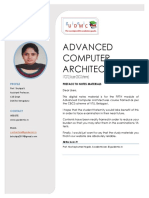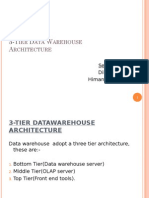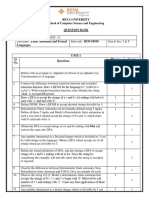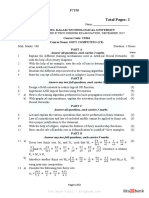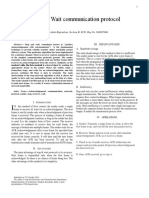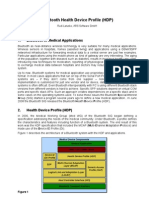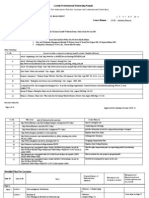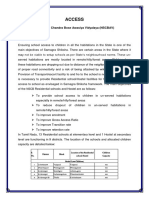0 ratings0% found this document useful (0 votes)
114 viewsChapter 8: Deadlocks: System Model Deadlock Characterization Methods For Handling Deadlocks
Chapter 8: Deadlocks: System Model Deadlock Characterization Methods For Handling Deadlocks
Uploaded by
Anonymous nLUdTm(1) Deadlock occurs when a set of processes are waiting for resources held by each other in a cyclic manner. (2) Four conditions must be met simultaneously for deadlock to occur: mutual exclusion, hold and wait, no preemption, and circular wait. (3) A resource-allocation graph can model resource usage, with processes and resources as vertices and allocation as edges; a cycle implies deadlock.
Copyright:
© All Rights Reserved
Chapter 8: Deadlocks: System Model Deadlock Characterization Methods For Handling Deadlocks
Chapter 8: Deadlocks: System Model Deadlock Characterization Methods For Handling Deadlocks
Uploaded by
Anonymous nLUdTm0 ratings0% found this document useful (0 votes)
114 views12 pages(1) Deadlock occurs when a set of processes are waiting for resources held by each other in a cyclic manner. (2) Four conditions must be met simultaneously for deadlock to occur: mutual exclusion, hold and wait, no preemption, and circular wait. (3) A resource-allocation graph can model resource usage, with processes and resources as vertices and allocation as edges; a cycle implies deadlock.
Original Description:
bauua sing
Original Title
ch_8_galvin
Copyright
© © All Rights Reserved
Share this document
Did you find this document useful?
Is this content inappropriate?
(1) Deadlock occurs when a set of processes are waiting for resources held by each other in a cyclic manner. (2) Four conditions must be met simultaneously for deadlock to occur: mutual exclusion, hold and wait, no preemption, and circular wait. (3) A resource-allocation graph can model resource usage, with processes and resources as vertices and allocation as edges; a cycle implies deadlock.
Copyright:
© All Rights Reserved
0 ratings0% found this document useful (0 votes)
114 views12 pagesChapter 8: Deadlocks: System Model Deadlock Characterization Methods For Handling Deadlocks
Chapter 8: Deadlocks: System Model Deadlock Characterization Methods For Handling Deadlocks
Uploaded by
Anonymous nLUdTm(1) Deadlock occurs when a set of processes are waiting for resources held by each other in a cyclic manner. (2) Four conditions must be met simultaneously for deadlock to occur: mutual exclusion, hold and wait, no preemption, and circular wait. (3) A resource-allocation graph can model resource usage, with processes and resources as vertices and allocation as edges; a cycle implies deadlock.
Copyright:
© All Rights Reserved
You are on page 1of 12
Chapter 8: Deadlocks
System Model
Deadlock Characterization
Methods for Handling Deadlocks
Operating System Concepts 8.1 Silberschatz, Galvin and Gagne 2002
The Deadlock Problem
A set of processes is in deadlock state when every process in
the set is waiting for an event that can be caused only by
another process in the set.
Under normal mode of operation, a process utilize a resource in
the following sequence:
Request –If the request can not granted immediately, then
the process has to wait until it can acquire the resource.Also
the process is added to the waiting queue of the device.
Use – The process can operate on the resource.
Release – The process releases the resource.
Resources may be physical resources(tape drives, memory
space and CPU cycles ) or logical resources(semaphores, files)
Operating System Concepts 8.2 Silberschatz, Galvin and Gagne 2002
Example of deadlock
Example- deadlock with same kind of device
System has 2 tape drives.
P1 and P2 each hold one tape drive and each needs
another one.
Example- deadlock with different device
System has one tape drive and one printer.
P1 is holding printer and P2 is holding tape drive.
Now if P1 requests tape drive and P2 requests
printer,system is in deadlock.
Example of logical resource (semaphore)
semaphores A and B, initialized to 1
P0 P1
wait (A); wait(B);
wait (B); wait(A);
Operating System Concepts 8.3 Silberschatz, Galvin and Gagne 2002
Deadlock Characterization
Deadlock can arise if four conditions hold simultaneously.
Mutual exclusion: Only one process at a time can use a
resource, so other requesting processes must wait.
Hold and wait: A process holding at least one resource is
waiting to acquire additional resources held by other
processes.
No preemption: A resource can be released only voluntarily
by the process holding it, after that process has completed its
task.
Circular wait: There exists a set {P0, P1, …, Pn} of waiting
processes such that P0 is waiting for a resource that is held
by P1, P1 is waiting for a resource that is held by P2,……
Pn-1 is waiting for a resource that is held by Pn, and Pn is
waiting for a resource that is held by P0.
Operating System Concepts 8.4 Silberschatz, Galvin and Gagne 2002
Resource-Allocation Graph
A set of vertices V and a set of edges E.
V is partitioned into two types:
P = {P1, P2, …, Pn}, the set consisting of all the
processes in the system.
R = {R1, R2, …, Rm}, the set consisting of all resource
types in the system.
request edge – directed edge Pi Rj
assignment edge – directed edge Rj Pi .
When a resource is allocated to the process, the request
edge is removed and assignment edge is added to the
graph.
Operating System Concepts 8.5 Silberschatz, Galvin and Gagne 2002
Resource-Allocation Graph (Cont.)
Process
Resource Type with 4 instances
Pi requests instance of Rj
Pi
Rjj
Pi is holding an instance of Rj
Pi
Rj
Operating System Concepts 8.6 Silberschatz, Galvin and Gagne 2002
Example of a Resource Allocation Graph
Operating System Concepts 8.7 Silberschatz, Galvin and Gagne 2002
If each resource in the graph has exactly one instance of
a resource then existence of cycle in the graph implies
deadlock.
But if multiple instances of a resource exist then
occurrence of cycle does not necessarily imply that
deadlock has occurred.
So for single instance resource allocation, existence of
cycle is necessary and sufficient condition for deadlock,
whereas for multiple instance resources, occurrence of
cycle is necessary but not sufficient condition for
deadlock.
Operating System Concepts 8.8 Silberschatz, Galvin and Gagne 2002
Resource Allocation Graph With A Deadlock
Operating System Concepts 8.9 Silberschatz, Galvin and Gagne 2002
Resource Allocation Graph With A Cycle But No
Deadlock
Operating System Concepts 8.10 Silberschatz, Galvin and Gagne 2002
Methods for Handling Deadlocks
We can deal with deadlocks in one of the three ways:
Ensure that the system will never enter a deadlock
state(deadlock prevention & deadlock avoidance)
Allow the system to enter a deadlock state and then
recover(deadlock detection and recovery)
Ignore the problem and pretend that deadlocks never occur
in the system; used by most operating systems, including
UNIX
Operating System Concepts 8.11 Silberschatz, Galvin and Gagne 2002
Deadlock Prevention – ensures that deadlock will never
occur by making sure that one of the 4 conditions required
for deadlock is not met.
Deadlock Avoidance – requires that OS should know
beforehand about the resource requirements of the
processes.
OS then makes sure before allocating resources to the
processes that it does not allocate such that cycle exist in
the resource allocation graph.
Operating System Concepts 8.12 Silberschatz, Galvin and Gagne 2002
You might also like
- RTN For SRC Instructions 1-BusDocument5 pagesRTN For SRC Instructions 1-Busprofessor_cuongNo ratings yet
- Advanced Computer Architectures: 17CS72 (As Per CBCS Scheme)Document31 pagesAdvanced Computer Architectures: 17CS72 (As Per CBCS Scheme)Aasim InamdarNo ratings yet
- Make It Simple But SignificantDocument44 pagesMake It Simple But Significantswetha reddy100% (5)
- Digital Design Interview QuestionsDocument24 pagesDigital Design Interview QuestionsprabhatNo ratings yet
- Demand Paging: Amna Ahmad Muhammad MustafaDocument24 pagesDemand Paging: Amna Ahmad Muhammad MustafaAmna Ahmad0% (1)
- Student Placement CellDocument123 pagesStudent Placement CellMayur prakash KambleNo ratings yet
- Lecture 18 Conditional Jumps Instructions PDFDocument7 pagesLecture 18 Conditional Jumps Instructions PDFSin Jie LimNo ratings yet
- Characteristics of A Good SRSDocument2 pagesCharacteristics of A Good SRSSridhar RaghuNo ratings yet
- Backup and RecoveryDocument35 pagesBackup and RecoverySanjana GargNo ratings yet
- Internet of Things Unit-5Document88 pagesInternet of Things Unit-5322203359001No ratings yet
- CO Unit 1-2Document14 pagesCO Unit 1-2Aravinder Reddy SuramNo ratings yet
- Open Book TestDocument2 pagesOpen Book Testjoshy_22No ratings yet
- 5 Unit 3 - Forward Chaining and Backward Chaining in AIDocument18 pages5 Unit 3 - Forward Chaining and Backward Chaining in AIROSHAN KUMAR 20SCSE1010194No ratings yet
- Cryptography and Network Security: List of PracticalDocument1 pageCryptography and Network Security: List of PracticalannuNo ratings yet
- Iot PDFDocument6 pagesIot PDFarun kaushikNo ratings yet
- DSA Lab Manual Solved by M.Daud Sajid 028 BSSE4A FA21Document162 pagesDSA Lab Manual Solved by M.Daud Sajid 028 BSSE4A FA21Daud SajidNo ratings yet
- BCS358D Data Visualization With Python SyallabusDocument4 pagesBCS358D Data Visualization With Python SyallabusWeb McaNo ratings yet
- Explain Group Communication - How Causal and Total Order Can Be Implemented? Group CommunicationDocument11 pagesExplain Group Communication - How Causal and Total Order Can Be Implemented? Group CommunicationvedarajNo ratings yet
- Resource Management in Iot-ClusteringDocument21 pagesResource Management in Iot-ClusteringHarish Muthyala0% (1)
- UNIT 2 - Connectionless and Connection Oriented Protocol PDFDocument115 pagesUNIT 2 - Connectionless and Connection Oriented Protocol PDFbalagsivaNo ratings yet
- Unit 4 AiDocument16 pagesUnit 4 AiShirly N100% (2)
- 3 Tier ArchitectureDocument9 pages3 Tier Architectureyour_friend1857100% (1)
- Theory of Automata 20 Most Important QuestionsDocument3 pagesTheory of Automata 20 Most Important Questionsshrey.bhaskar.it.2021No ratings yet
- TOC Question Bank - Unit - 1 - 2 - 3 - 4 - 2022Document7 pagesTOC Question Bank - Unit - 1 - 2 - 3 - 4 - 2022venkata karthikNo ratings yet
- What Is Classic Ethernet MAC Sublayer ProtocolDocument2 pagesWhat Is Classic Ethernet MAC Sublayer ProtocolDon WaltonNo ratings yet
- Compilation Process in CDocument4 pagesCompilation Process in CPaulNo ratings yet
- Mutex Locks (Os Presentation)Document19 pagesMutex Locks (Os Presentation)Ali RazaNo ratings yet
- 4g Technology AbstractDocument3 pages4g Technology AbstractPurnima KNo ratings yet
- 6.2 Elements of Transport Protocols PDFDocument12 pages6.2 Elements of Transport Protocols PDFRoshni KhuranaNo ratings yet
- AI Anna University Important QuestionsDocument2 pagesAI Anna University Important QuestionsRomaldoNo ratings yet
- Structure of C++Document5 pagesStructure of C++Terry Clarice DecatoriaNo ratings yet
- RTOSDocument1 pageRTOSvpsompur0% (1)
- Input and Output Text and Binary I/O: Introduction To Java Y.Daniel Liang 1Document64 pagesInput and Output Text and Binary I/O: Introduction To Java Y.Daniel Liang 1Deepak ChaudharyNo ratings yet
- Total Pages: 2: Answer All Questions, Each Carries 3 MarksDocument2 pagesTotal Pages: 2: Answer All Questions, Each Carries 3 MarksshakirckNo ratings yet
- Software Engineering Chapter 11Document52 pagesSoftware Engineering Chapter 11nitin gupta100% (1)
- William Stallings Computer Organization and Architecture 8 EditionDocument55 pagesWilliam Stallings Computer Organization and Architecture 8 EditionflowrentsiaNo ratings yet
- Case Study of LinuxDocument8 pagesCase Study of LinuxabhyaNo ratings yet
- Cs9251 Mobile Computing 2marks 16marks Question PapersDocument11 pagesCs9251 Mobile Computing 2marks 16marks Question PapersNivithaNo ratings yet
- Assignment of Generic Models (Software Engineering)Document8 pagesAssignment of Generic Models (Software Engineering)Kashif IftikharNo ratings yet
- DeadlockDocument41 pagesDeadlockapi-26557430No ratings yet
- Awp Course FileDocument24 pagesAwp Course FilevijaykannamallaNo ratings yet
- Comparison of OSI Reference Model and TCP ModelDocument2 pagesComparison of OSI Reference Model and TCP ModelThaddeus MooreNo ratings yet
- Title:: Write A Program To Demonstrate Subnetting and Find The Subnet MasksDocument10 pagesTitle:: Write A Program To Demonstrate Subnetting and Find The Subnet MasksDarshan DerleNo ratings yet
- Collision Free ProtocolsDocument15 pagesCollision Free ProtocolsAli AhammadNo ratings yet
- Iot Physical DevicesDocument22 pagesIot Physical DevicesMalajebamaniraj MalaNo ratings yet
- CN Stop and Wait ProtocolDocument3 pagesCN Stop and Wait ProtocolPriyadarshini RNo ratings yet
- Unit III - Preprocessor & FilesDocument28 pagesUnit III - Preprocessor & FilesMalathiBhuvanNo ratings yet
- 11-Best Case, Worst Case, Average Case Analysis-08-08-2022Document45 pages11-Best Case, Worst Case, Average Case Analysis-08-08-2022IshankNo ratings yet
- Software For Embedded SystemDocument39 pagesSoftware For Embedded Systemjani28cseNo ratings yet
- Bluetooth HDPDocument5 pagesBluetooth HDPManuella Dias Carvalho SilvaNo ratings yet
- Incremental ModelDocument3 pagesIncremental Modelতোর বাপNo ratings yet
- Unit 2 Topic 10 Sliding Window ProtocolDocument19 pagesUnit 2 Topic 10 Sliding Window Protocolashok_it87100% (1)
- Embedded Firmware (Unit - Iii)Document18 pagesEmbedded Firmware (Unit - Iii)jonnyNo ratings yet
- 5CS4-03 - Operating System - Kajal MathurDocument157 pages5CS4-03 - Operating System - Kajal MathurIshaan KhandelwalNo ratings yet
- OS 2 MarksDocument15 pagesOS 2 Marksapi-3693857100% (11)
- Experiment No. 1: TheoryDocument7 pagesExperiment No. 1: TheoryAzrul Ikhwan ZulkifliNo ratings yet
- JDBCDocument37 pagesJDBCshubhamNo ratings yet
- Data Link Protocols: Unrestricted Simplex Protocol Simplex Stop-And-Wait Protocol Simplex Protocol For A Noisy ChannelDocument6 pagesData Link Protocols: Unrestricted Simplex Protocol Simplex Stop-And-Wait Protocol Simplex Protocol For A Noisy Channelraw.junkNo ratings yet
- Mass Storage StructureDocument35 pagesMass Storage Structureapi-25906715100% (1)
- CH 8Document41 pagesCH 8tasmia abedinNo ratings yet
- CH 8Document41 pagesCH 8Ujjawal MallikNo ratings yet
- Chapter 7: DeadlocksDocument21 pagesChapter 7: Deadlockshafiz rahmadNo ratings yet
- Chapter 8: Deadlocks: Silberschatz, Galvin and Gagne ©2018 Operating System Concepts - 10 EditionDocument43 pagesChapter 8: Deadlocks: Silberschatz, Galvin and Gagne ©2018 Operating System Concepts - 10 EditionSuhaib masalhaNo ratings yet
- GATE Syllabus Computer Science and Information TechnologyDocument3 pagesGATE Syllabus Computer Science and Information TechnologyLalit jadhavNo ratings yet
- ABB MV Switchgear - Single Busbar or Double Busbar - PDFDocument6 pagesABB MV Switchgear - Single Busbar or Double Busbar - PDFrod8silvaNo ratings yet
- Ultra-High-Performance Concrete Impacts of Steel Fibre Shape and Content On Flowability, Compressive Strength and Modulus of RuptureDocument7 pagesUltra-High-Performance Concrete Impacts of Steel Fibre Shape and Content On Flowability, Compressive Strength and Modulus of RuptureS. QaidiNo ratings yet
- Sales Management - Mgt304Document17 pagesSales Management - Mgt304meetpalNo ratings yet
- Module 1 (PART 2) - Introduction To C LanguageDocument19 pagesModule 1 (PART 2) - Introduction To C Languagehchandrika116No ratings yet
- WSP Indonesia WSS Turning Finance Into Service For The FutureDocument88 pagesWSP Indonesia WSS Turning Finance Into Service For The FutureLutfi LailaNo ratings yet
- Put Ratio Spread: Limited Profit PotentialDocument4 pagesPut Ratio Spread: Limited Profit PotentialAbhijit SenguptaNo ratings yet
- A Combinatorial Approach To Level of Repair AnalysisDocument10 pagesA Combinatorial Approach To Level of Repair AnalysisŞahin ALPASLANNo ratings yet
- Tugas m10Document6 pagesTugas m10Ahmad Farhan JabirNo ratings yet
- Paygilant - Frictionless Fraud PreventionDocument17 pagesPaygilant - Frictionless Fraud PreventionGlobalys LtdNo ratings yet
- Wildfire Are You PreparedDocument4 pagesWildfire Are You PreparedPlainNormalGuy2No ratings yet
- CottonKing CaseDocument2 pagesCottonKing CaseBhavikNo ratings yet
- Beedi and Cigar Workers Conditions of Employment Act 1966Document15 pagesBeedi and Cigar Workers Conditions of Employment Act 1966Himanshu RajpurohitNo ratings yet
- DWA-110 A1 Manual 1.10 PDFDocument63 pagesDWA-110 A1 Manual 1.10 PDFRoberth Tulio ColoniaNo ratings yet
- PAS Kls 11 SMT 1Document10 pagesPAS Kls 11 SMT 1muhdiah969No ratings yet
- Brochures - x-AV3 - GX2 - DX2Document16 pagesBrochures - x-AV3 - GX2 - DX2hector tosarNo ratings yet
- Amway New PlanDocument14 pagesAmway New PlanPriyaranjanNo ratings yet
- Diamond Sources and Production Past Present and FutureDocument21 pagesDiamond Sources and Production Past Present and FutureChressa RufonNo ratings yet
- MODULE 3-CHAPTER 12 The Civil Engineering Professional Licensure ExaminationDocument4 pagesMODULE 3-CHAPTER 12 The Civil Engineering Professional Licensure ExaminationJerichoRoiEspirituTabangNo ratings yet
- Query Languages - DPP 01 Discussion NotesDocument12 pagesQuery Languages - DPP 01 Discussion Notesajayvaliya831No ratings yet
- Grammar Test: Choose The Correct Answers To Complete The SentencesDocument4 pagesGrammar Test: Choose The Correct Answers To Complete The SentencesDraganNo ratings yet
- NSCB EnglishDocument5 pagesNSCB EnglishMannem Pavan Kumar100% (1)
- BresadkjfjeDocument22 pagesBresadkjfjeshailesh.patelNo ratings yet
- Tandem Axle Machine PPT1 PDFDocument9 pagesTandem Axle Machine PPT1 PDFSaurabh GourNo ratings yet
- Signal Integrity Challenges in 3D ICDocument5 pagesSignal Integrity Challenges in 3D ICrakeshNo ratings yet
- Bea GSA Price ListDocument29 pagesBea GSA Price ListAnonymous ZWtrbvgHwpNo ratings yet
- Multi-Feature DALI Dimmer For W, TW, RGB, RGBW, With CV Solutions DT6 and DT8Document2 pagesMulti-Feature DALI Dimmer For W, TW, RGB, RGBW, With CV Solutions DT6 and DT8Hoang HaNo ratings yet

